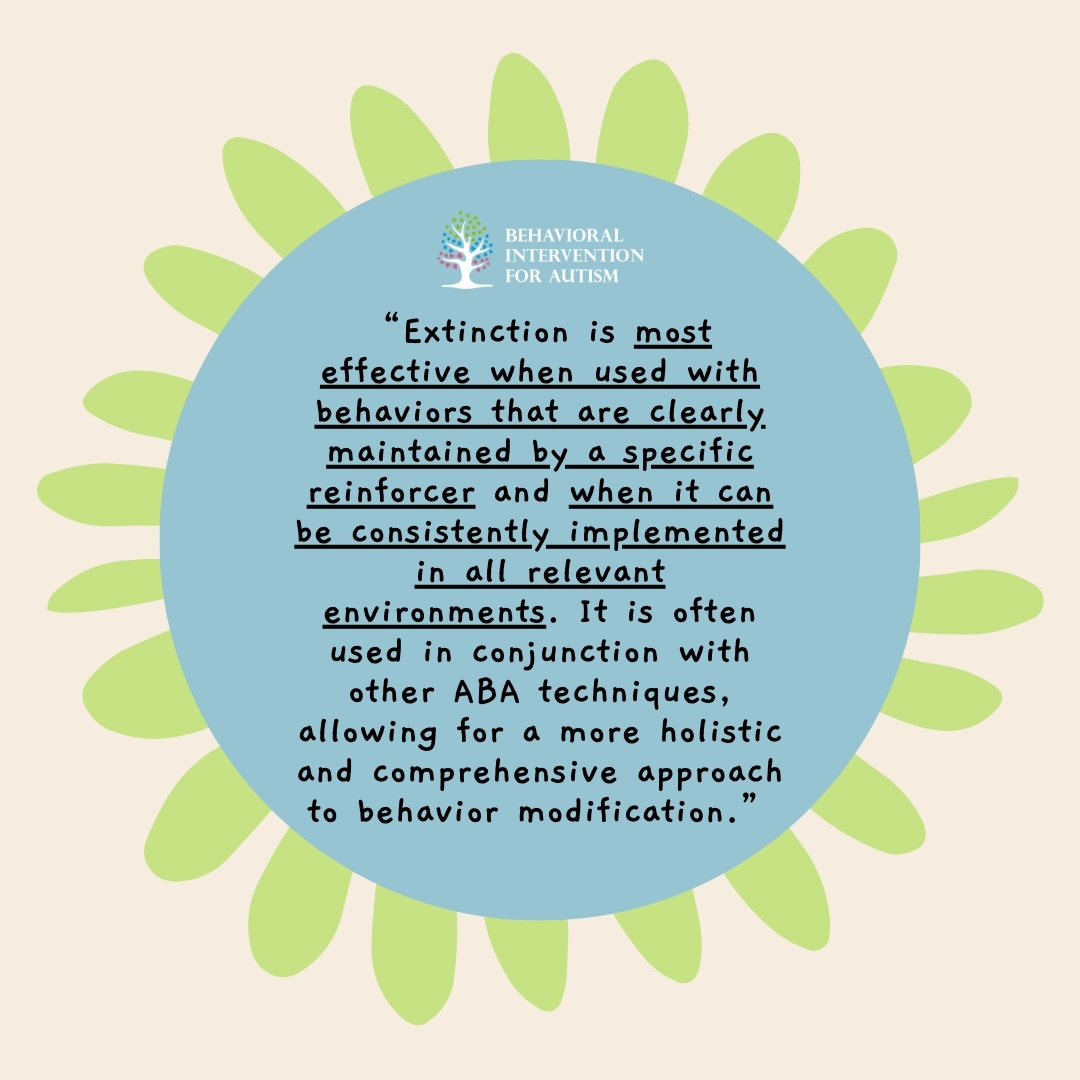
Table of Contents
Extinction in Applied Behavior Analysis (ABA) therapy refers to the process of reducing or eliminating a behavior by stopping reinforcement that previously maintained the behavior. This technique is based on the principle that when a behavior is no longer reinforced, it will gradually decrease in frequency over time. ABA therapists use extinction as a key strategy to target undesirable behaviors that have been reinforced, either intentionally or unintentionally, by caregivers, teachers, or peers.
The foundation of extinction is built upon the concept of reinforcement. Reinforcement strengthens a behavior by providing a consequence that the individual finds rewarding, encouraging them to repeat the behavior. Extinction, conversely, seeks to remove that rewarding consequence, making the behavior less likely to occur.
ABA therapy uses this principle in various ways, from reducing tantrums to eliminating self-injurious behavior. It’s important to understand that extinction doesn’t involve punishment or aversive stimuli; it simply involves the removal of the reinforcer.
3 Types of Extinction in ABA Therapy
There are different types of extinction that ABA therapists utilize depending on the nature of the behavior they are addressing. These types include:
1. Attention Extinction
Attention extinction is commonly used for behaviors that are maintained by attention-seeking. This occurs when an individual engages in a behavior to gain attention from others, such as asking for help inappropriately, making noises, or using disruptive behavior. In this form of extinction, the therapist or caregiver will stop providing attention in response to the undesired behavior, thus reducing its occurrence over time.
2. Escape Extinction
Escape extinction is typically applied when a behavior is maintained by an individual’s desire to avoid or escape a certain demand, task, or situation. A child might exhibit behaviors like whining, tantrums, or refusal to participate in tasks to avoid unpleasant or challenging activities. In this case, the therapist or caregiver will continue to present the demand or task, even in the face of the challenging behavior, thus preventing the reinforcement of avoidance. Over time, the child learns that the behavior will not result in escape.
3. Tangible Extinction
Tangible extinction is used when a behavior is maintained by access to tangible items or activities. For example, a child may exhibit tantrums or other problem behaviors to gain access to a toy, food, or specific activity. When implementing tangible extinction, the caregiver or therapist will withhold the desired item or activity following the behavior, ensuring that the behavior is not reinforced by the tangible reward.
How Extinction is Implemented in ABA Therapy
The process of implementing extinction in ABA therapy requires careful planning and consistency. Here’s how it is typically done:
1. Identify the Reinforcer
Before starting the extinction process, it is essential to identify the specific reinforcer that maintains the problem behavior. Whether it is attention, escape, or tangible items, this step involves thorough observation to understand the function of the behavior. By identifying the reinforcer, therapists can ensure they are addressing the root cause of the behavior.
2. Stop Reinforcing the Behavior
Once the reinforcer is identified, the therapist will stop providing the reinforcement when the undesirable behavior occurs. This is a critical aspect of extinction. For example, if a child is throwing a tantrum to gain attention, the therapist will no longer provide attention during the tantrum.
3. Implement Consistency Across Environments
To achieve success, extinction must be implemented consistently across all environments where the behavior occurs. Caregivers, teachers, and other individuals working with the child must understand the goal of extinction and consistently refrain from reinforcing the problem behavior.
4. Monitor the Behavior
As the extinction procedure is implemented, therapists closely monitor the behavior to track progress. It’s important to note that initially, the behavior may intensify before it starts to decrease, a phenomenon known as an “extinction burst.” This temporary increase in behavior is a natural part of the process, as the individual may escalate their attempts to gain reinforcement before realizing it will no longer work.
5. Gradually Shift to Alternative Reinforcements
While extinction eliminates the unwanted behavior, it’s also essential to introduce and reinforce alternative, more appropriate behaviors. This might include teaching the individual to communicate their needs in a socially acceptable way or engaging in a more positive behavior that can also be reinforced.
4 Challenges and Considerations in Using Extinction
Though extinction is a valuable tool in ABA therapy, it comes with its challenges. It’s important for therapists and caregivers to consider the following:
1. Extinction Burst
As mentioned earlier, an extinction burst refers to the temporary increase in the problem behavior when the reinforcer is first removed. This burst of behavior can be challenging for both the child and the caregiver, as the child may become more agitated or frustrated before the behavior starts to diminish. Caregivers must be prepared for this and remain consistent in their approach.
2. Emotional Reactions and Aggression
In some cases, when the reinforcement is withheld, the individual may display emotional reactions such as anger, frustration, or aggression. This can be particularly challenging when working with children who have difficulty managing their emotions. Therapists must ensure they are equipped with strategies to manage these emotional outbursts while maintaining the integrity of the extinction process.
3. Differentiating Between Extinction and Punishment
It is critical to differentiate between extinction and punishment. While extinction involves the removal of reinforcement, punishment involves the introduction of aversive stimuli. Extinction should not be confused with punitive approaches, as the goal is to reduce behaviors by removing rewards, not by adding discomfort or pain.
4. Ethical Considerations
Ethically, it’s crucial that extinction procedures are implemented in a manner that respects the dignity and well-being of the individual. ABA therapists must ensure that the behavior being addressed is not a symptom of underlying emotional distress or other mental health issues. The goal should always be to teach the individual more appropriate behaviors, rather than simply eliminating behaviors.
The Role of Extinction in Behavioral Interventions
Extinction plays a critical role in many behavioral interventions. By eliminating reinforcement for unwanted behaviors, it helps individuals learn more adaptive ways of coping with situations. ABA therapists use extinction in conjunction with other strategies, such as reinforcement of alternative behaviors, to promote lasting behavior change.
For example, in teaching a child to communicate their needs more effectively, extinction might be used to reduce maladaptive behaviors like aggression or whining, while reinforcing appropriate communication methods, like using words or pictures. Over time, the individual learns that positive behaviors lead to desirable outcomes, while problem behaviors no longer provide reinforcement.
When to Use Extinction in ABA Therapy
While extinction can be a powerful tool, it’s not always appropriate for every situation. ABA therapists must carefully assess the behavior and determine if extinction is the most effective approach. Some behaviors may be better addressed with other strategies, such as differential reinforcement, behavior chaining, or shaping.

Extinction is a powerful and essential technique in ABA therapy for reducing unwanted behaviors by removing the reinforcement that maintains them. While it can be challenging, particularly during the initial stages when the behavior may intensify, its effectiveness over time can significantly improve the individual’s behavior. By implementing extinction carefully and consistently, and by reinforcing alternative behaviors, therapists can help individuals with autism spectrum disorder develop more appropriate and adaptive behaviors.
Get Started with Effective ABA Therapy Today
If you’re looking for ABA therapy in Florida, we’re here to help. Our team at Behavioral Intervention for Autism specializes in providing personalized therapy designed to meet the unique needs of each individual. By using proven strategies like extinction, we work with you to create lasting positive behavior changes. Contact us now to learn how we can support your loved one’s development, or schedule a consultation to see how we can make a difference. Experience the quality of our services and discover the transformative power of ABA therapy for your family. Reach out today and take the first step!
- 9 Common Obsessions of Children With Autism You Should Know - February 25, 2025
- What is Neurodiversity? A Guide to Embracing Differences - February 25, 2025
- Understanding Hyperfocus in Autism: What It Means and Why It Happens - February 25, 2025

